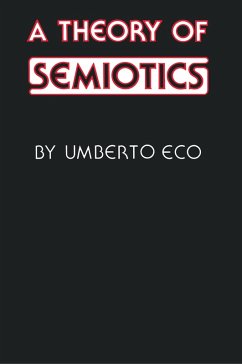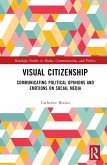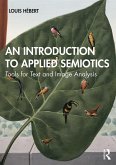Umberto Eco
A Theory of Semiotics
29,99 €
inkl. MwSt.
Versandfertig in über 4 Wochen

15 °P sammeln
Umberto Eco
A Theory of Semiotics
- Broschiertes Buch
- Merkliste
- Auf die Merkliste
- Bewerten Bewerten
- Teilen
- Produkt teilen
- Produkterinnerung
- Produkterinnerung
Focuses on the twin problems of the doctrine of signs - communication and signification - and offers a highly original theory of sign production, including a carefully wrought typology of signs and modes of production.
Andere Kunden interessierten sich auch für
![Multimodality Multimodality]() Gunther KressMultimodality51,99 €
Gunther KressMultimodality51,99 €![COVID Semiotics COVID Semiotics]() COVID Semiotics38,99 €
COVID Semiotics38,99 €![Discourse and Power Discourse and Power]() Peter V. ZimaDiscourse and Power168,99 €
Peter V. ZimaDiscourse and Power168,99 €![Semiotics: The Basics Semiotics: The Basics]() Daniel ChandlerSemiotics: The Basics105,99 €
Daniel ChandlerSemiotics: The Basics105,99 €![Discourse and Power Discourse and Power]() Peter V. ZimaDiscourse and Power41,99 €
Peter V. ZimaDiscourse and Power41,99 €![Visual Citizenship Visual Citizenship]() Catherine BoukoVisual Citizenship181,99 €
Catherine BoukoVisual Citizenship181,99 €![An Introduction to Applied Semiotics An Introduction to Applied Semiotics]() Louis HebertAn Introduction to Applied Semiotics55,99 €
Louis HebertAn Introduction to Applied Semiotics55,99 €-
-
-
Focuses on the twin problems of the doctrine of signs - communication and signification - and offers a highly original theory of sign production, including a carefully wrought typology of signs and modes of production.
Produktdetails
- Produktdetails
- Verlag: Indiana University Press
- Seitenzahl: 368
- Erscheinungstermin: 22. November 1978
- Englisch
- Abmessung: 229mm x 152mm x 21mm
- Gewicht: 532g
- ISBN-13: 9780253202178
- ISBN-10: 0253202175
- Artikelnr.: 21656344
- Herstellerkennzeichnung
- Libri GmbH
- Europaallee 1
- 36244 Bad Hersfeld
- gpsr@libri.de
- Verlag: Indiana University Press
- Seitenzahl: 368
- Erscheinungstermin: 22. November 1978
- Englisch
- Abmessung: 229mm x 152mm x 21mm
- Gewicht: 532g
- ISBN-13: 9780253202178
- ISBN-10: 0253202175
- Artikelnr.: 21656344
- Herstellerkennzeichnung
- Libri GmbH
- Europaallee 1
- 36244 Bad Hersfeld
- gpsr@libri.de
Umberto Eco
Foreword
Note on graphic conventions
0. Introduction-Toward a Logic of Culture
0.1. Design for a semiotic theory
0.2. 'Semiotics': field or discipline?
0.3. Communication and/or signification
0.4. Political boundaries: the field
0.5. Natural boundaries: two definitions of semiotics
0.6. Natural boundaries: inference and signification
0.7. Natural boundaries; the lower threshold
0.8. Natural boundaries: the upper threshold
0.9. Epistemological boundaries
1. Signification and Communication
1.1. An elementary communicational model
1.2. Systems and codes
1.3. The s-code as structure
1.4. Information, communication, signification
2. Theory of Codes
2.1. The sign-function
2.2. Expression and content
2.3. Denotation and connotation
2.4. Message and text
2.5 Content and referent
2.6. Meaning as cultural unit
2.7. The interpretant
2.8. The semantic system
2.9. The semantic markers and the sememe
2.10. The KF model
2.11. A revised semantic model
2.12. The model "Q"
2.13. The format of the semantic space
2.14. Overcoding and undercoding
2.15. The interplay of codes and the message as an open form
3. Theory of Sign Production
3.1. A general survey
3.2. Semiotic and factual statements
3.3. Mentioning
3.4 The prolem of a typology of signs
3.5. Critique of iconism
3.6. A typology of modes of production
3.7. The aesthetic text as invention
3.8. The rhetorical labor
3.9. Ideological code switching
4. The Subject of Semiotics
References
Index of authors
Index of subjects
Note on graphic conventions
0. Introduction-Toward a Logic of Culture
0.1. Design for a semiotic theory
0.2. 'Semiotics': field or discipline?
0.3. Communication and/or signification
0.4. Political boundaries: the field
0.5. Natural boundaries: two definitions of semiotics
0.6. Natural boundaries: inference and signification
0.7. Natural boundaries; the lower threshold
0.8. Natural boundaries: the upper threshold
0.9. Epistemological boundaries
1. Signification and Communication
1.1. An elementary communicational model
1.2. Systems and codes
1.3. The s-code as structure
1.4. Information, communication, signification
2. Theory of Codes
2.1. The sign-function
2.2. Expression and content
2.3. Denotation and connotation
2.4. Message and text
2.5 Content and referent
2.6. Meaning as cultural unit
2.7. The interpretant
2.8. The semantic system
2.9. The semantic markers and the sememe
2.10. The KF model
2.11. A revised semantic model
2.12. The model "Q"
2.13. The format of the semantic space
2.14. Overcoding and undercoding
2.15. The interplay of codes and the message as an open form
3. Theory of Sign Production
3.1. A general survey
3.2. Semiotic and factual statements
3.3. Mentioning
3.4 The prolem of a typology of signs
3.5. Critique of iconism
3.6. A typology of modes of production
3.7. The aesthetic text as invention
3.8. The rhetorical labor
3.9. Ideological code switching
4. The Subject of Semiotics
References
Index of authors
Index of subjects
Foreword
Note on graphic conventions
0. Introduction-Toward a Logic of Culture
0.1. Design for a semiotic theory
0.2. 'Semiotics': field or discipline?
0.3. Communication and/or signification
0.4. Political boundaries: the field
0.5. Natural boundaries: two definitions of semiotics
0.6. Natural boundaries: inference and signification
0.7. Natural boundaries; the lower threshold
0.8. Natural boundaries: the upper threshold
0.9. Epistemological boundaries
1. Signification and Communication
1.1. An elementary communicational model
1.2. Systems and codes
1.3. The s-code as structure
1.4. Information, communication, signification
2. Theory of Codes
2.1. The sign-function
2.2. Expression and content
2.3. Denotation and connotation
2.4. Message and text
2.5 Content and referent
2.6. Meaning as cultural unit
2.7. The interpretant
2.8. The semantic system
2.9. The semantic markers and the sememe
2.10. The KF model
2.11. A revised semantic model
2.12. The model "Q"
2.13. The format of the semantic space
2.14. Overcoding and undercoding
2.15. The interplay of codes and the message as an open form
3. Theory of Sign Production
3.1. A general survey
3.2. Semiotic and factual statements
3.3. Mentioning
3.4 The prolem of a typology of signs
3.5. Critique of iconism
3.6. A typology of modes of production
3.7. The aesthetic text as invention
3.8. The rhetorical labor
3.9. Ideological code switching
4. The Subject of Semiotics
References
Index of authors
Index of subjects
Note on graphic conventions
0. Introduction-Toward a Logic of Culture
0.1. Design for a semiotic theory
0.2. 'Semiotics': field or discipline?
0.3. Communication and/or signification
0.4. Political boundaries: the field
0.5. Natural boundaries: two definitions of semiotics
0.6. Natural boundaries: inference and signification
0.7. Natural boundaries; the lower threshold
0.8. Natural boundaries: the upper threshold
0.9. Epistemological boundaries
1. Signification and Communication
1.1. An elementary communicational model
1.2. Systems and codes
1.3. The s-code as structure
1.4. Information, communication, signification
2. Theory of Codes
2.1. The sign-function
2.2. Expression and content
2.3. Denotation and connotation
2.4. Message and text
2.5 Content and referent
2.6. Meaning as cultural unit
2.7. The interpretant
2.8. The semantic system
2.9. The semantic markers and the sememe
2.10. The KF model
2.11. A revised semantic model
2.12. The model "Q"
2.13. The format of the semantic space
2.14. Overcoding and undercoding
2.15. The interplay of codes and the message as an open form
3. Theory of Sign Production
3.1. A general survey
3.2. Semiotic and factual statements
3.3. Mentioning
3.4 The prolem of a typology of signs
3.5. Critique of iconism
3.6. A typology of modes of production
3.7. The aesthetic text as invention
3.8. The rhetorical labor
3.9. Ideological code switching
4. The Subject of Semiotics
References
Index of authors
Index of subjects







